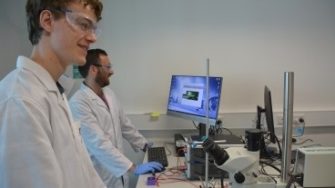- UNSW
- ...
- Our schools
- Materials Science & Engineering
- Our research
- ✅Biomedical & health
- Polymer Research in Therapeutics Group
- Home
- About us
- Study with us
- Our research
-
Student life & resources
-
Undergraduate program plans pre 2024
- Bachelor of Engineering (Materials Science & Engineering) (Honours)
- Bachelor of Engineering (Materials Science & Engineering) (Honours)/Master of Biomedical Engineering
- Bachelor of Engineering (Materials Science) (Honours)/Commerce
- Bachelor of Engineering (Materials Science & Engineering) (Honours)/Engineering Science
-
Undergraduate program plans 2024 onwards
- Bachelor of Engineering (Materials Science & Engineering) (Honours) New Program 2024 Onwards
- Bachelor of Engineering (Materials Science & Engineering) (Honours)/Master of Biomedical Engineering New Program 2024 Onwards
- Bachelor of Engineering (Materials Science) (Honours)/Commerce New Program 2024 Onwards
- Bachelor of Engineering (Materials Science & Engineering) (Honours)/Engineering Science New Program 2024 Onwards
- Postgraduate program plan
- Course outlines
- Important information for all coursework students
- Work integrated learning
- Careers and industries
- Student societies
- Exchange programs
- Life on Campus
-
Undergraduate program plans pre 2024
- Engage with us
- News and events
- Home
- About us
- Study with us
- Our research
-
Student life & resources
Undergraduate program plans pre 2024
- Bachelor of Engineering (Materials Science & Engineering) (Honours)
- Bachelor of Engineering (Materials Science & Engineering) (Honours)/Master of Biomedical Engineering
- Bachelor of Engineering (Materials Science) (Honours)/Commerce
- Bachelor of Engineering (Materials Science & Engineering) (Honours)/Engineering Science
Undergraduate program plans 2024 onwards
- Bachelor of Engineering (Materials Science & Engineering) (Honours) New Program 2024 Onwards
- Bachelor of Engineering (Materials Science & Engineering) (Honours)/Master of Biomedical Engineering New Program 2024 Onwards
- Bachelor of Engineering (Materials Science) (Honours)/Commerce New Program 2024 Onwards
- Bachelor of Engineering (Materials Science & Engineering) (Honours)/Engineering Science New Program 2024 Onwards
- Engage with us
- News and events

Who we are
The Polymer Research in Therapeutics (PRinT) Group focuses on developing organic bioelectronic devices using novel, functional conjugated polymers and biopolymer composites. Our multidisciplinary team brings together expertise from chemistry, physics, biology and materials science.





Research program
Conjugated polymers exhibit electronic and ionic conductivity, providing better interaction with biological systems, while having no pesky oxide layer that decreases conductivity. Soft and flexible bioelectronics focuses on the development of conjugated polymer-based devices applied at the interface with electro-responsive tissues. Achieving this goal requires a multidisciplinary approach:
- Chemistry is relevant to the synthesis of new, electroactive materials.
- Physics aids us in implementing these materials in devices.
- Biology allows us to optimise the interface between these devices and biological systems.
- Materials science helps us understand the optical, electronic and morphological properties of these materials.
Synthesis of organic conductive materials
We apply versatile chemistries to enable the introduction of functional groups on the polymer to modulate the interface between the conjugated polymer and tissue. Furthermore, through these modifications the polymer can be made water soluble, which is a significant benefit in terms of processability, morphological control and fine tuning of physical properties.

Device physics and optoelectronics
We aim to create flexible and conformable bioelectronic devices with tunable performances independent of the device footprint. We provide guidelines for the design of materials that will lead to state-of-the-art bioelectronics. We exploit the electronic properties of these materials to build bioelectronic circuitry and their optoelectronic properties to create wireless devices.

Biointegration of devices
We want to improve the integration of bioelectronic devices with tissue. Implantable bioelectronic devices should have an intimate contact with the electroresponsive tissue in order to stimulate or process electrophysiological signals. This can be achieved by changing the morphology of the polymer and understanding the sterilisation process applied to these devices. In both cases, it is crucial to investigate the effects on the functional properties of the device and its immune response in vivo.






